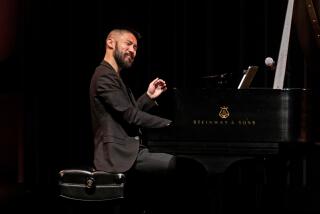For Gary Graffman, one hand is enough
- Share via
Pianist Gary Graffman brought the sound of one hand playing to Cal State Fullerton’s Meng Concert Hall on Sunday afternoon in a recital consisting entirely of works for the left hand. Funny thing, though: His one hand sounded better than many pianists’ two.
Graffman, almost 79, lost full use of his right hand at 50 and, like his near contemporary Leon Fleisher, suffers from focal dystonia, a muscular disorder. Both musicians have turned their misfortune into strength by becoming leading exponents of the left-hand piano literature.
Most of us are familiar with Ravel’s Concerto for the Left Hand, but does anyone know Max Reger’s compelling Four Special Studies or Carl Reinecke’s finely crafted Sonata, Opus 179? Under Graffman’s muscular and sensitive fingers, these demanding pieces elicited almost visceral pleasure.
In such repertoire, and without the right hand to cover flaws, there’s no place for the left to hide. There is the damper pedal, however, which can create a wash of sound that simulates two hands playing. Graffman relied on it too much in Brahms’ arrangement for the left hand of Bach’s Chaconne, leaving unrealized much of the work’s divine architecture and emotional-spiritual power.
Graffman’s mellow tone and more judicious pedaling in the shorter works conveyed a greater range of moods. He was ruminative in Scriabin’s Nocturne in D flat, eloquent in Leon Kirchner’s “For the Left Hand” (composed for Fleisher in 1995) and charming in Felix Blumenfeld’s rippling Etude in A flat. In a pair of Chopin/Godowsky etudes, he was especially lyrical in the Etude in E-flat minor.
For John Corigliano’s Etude No. 1 from “Etude Fantasy,” Graffman adopted a steelier tone, exploring darker registers -- a throwback to his days as a leading interpreter of Prokofiev.
Throughout the recital, Graffman used a score. (One advantage to the left-hand repertoire: You can turn your own pages.) But that’s understandable, even desirable. This was a strenuous, gutsy program performed with quiet intensity and considerable stamina.
Indeed, Graffman embodied the notion of how much a musician is like an athlete, relying on poise and balance. At times, as he twisted his body and moved his left arm to the piano’s treble side, his right hand gripped the Steinway. Not just to generate more sonic power, but, as he wrote in his informative program notes, “to avoid. . . being catapulted into the audience.”
And there was further drama here, of pressing up against limits and exceeding them. In Scriabin’s passionate Etude in C-sharp minor arranged for the left hand by Jay Reise, Graffman’s sense of struggle was invigorating, drawing the audience in.
Understandably, there was only one encore: Mompou’s Prelude No. 6, exquisitely rendered.
More to Read
The biggest entertainment stories
Get our big stories about Hollywood, film, television, music, arts, culture and more right in your inbox as soon as they publish.
You may occasionally receive promotional content from the Los Angeles Times.










